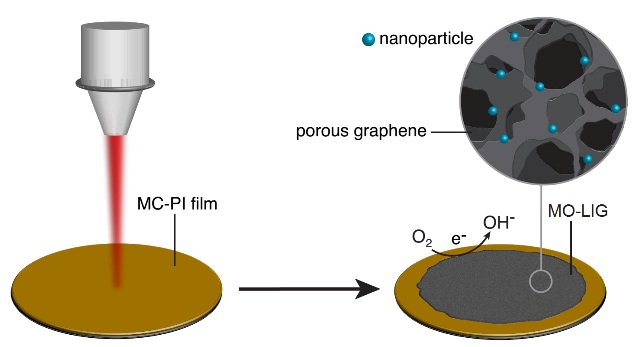Researchers at Rice University have discovered a new way to integrate metallic nanoparticles that convert graphene into a viable catalyst for various applications, including fuel cells.
 Rice University chemists have found a way to embed metallic nanoparticles into laser-induced graphene. The particles turn the material into a useful catalyst for fuel cell and other applications. (Credit: Tour Group/Rice University)
Rice University chemists have found a way to embed metallic nanoparticles into laser-induced graphene. The particles turn the material into a useful catalyst for fuel cell and other applications. (Credit: Tour Group/Rice University)
Last year, Rice lab chemist James Tour developed a unique form of laser-induced graphene - a flexible film featuring a porous graphene surface which was developed by subjecting a polyimide plastic to a commercial laser-scribing beam. The research team has now found a new way to improve the material with reactive metals. The study has been published in the American Chemical Society journal, ACS Nano.
With the latest discovery, the material, called metal oxide-laser induced graphene (MO-LIG), can be used in substitute for costly metals such as platinum in catalytic fuel-cell applications, where hydrogen and oxygen are changed to electricity and water.
“The wonderful thing about this process is that we can use commercial polymers, with simple inexpensive metal salts added,” Tour said. “We then subject them to the commercial laser scriber, which generates metal nanoparticles embedded in graphene. So much of the chemistry is done by the laser, which generates graphene in the open air at room temperature."
Tour went on to say: "These composites, which have less than 1 percent metal, respond as ‘super catalysts’ for fuel-cell applications. Other methods to do this take far more steps and require expensive metals and expensive carbon precursors.”
The scientists initially developed laser-induced graphene with polyimide sheets that are commercially available in the market, and then used boron to infuse liquid polyimide to create laser-induced graphene.
This graphene served as an effective supercapacitor as it showed an improved capacity to store a single electrical charge. The researchers again repeated the process, where they combined the liquid with one of the three concentrations comprising molybdenum, iron, or cobalt metal salts.
Once the individual mixture was condensed into a film, it was subjected to an infrared laser, and subsequently heated in argon gas for a period of 30 minutes at 7500 ºC. This process resulted in strong MO-LIGs with metallic, 10 nm particles that were uniformly distributed across the graphene.
Tour said that several tests were carried out which demonstrated the ability of MO-LIGs to catalyze oxygen reduction, a critical chemical reaction that takes place in fuel cells. When the material was further doped with sulfur, it resulted in hydrogen evolution, which is another critical catalytic process that changes water into hydrogen.
“Remarkably, simple treatment of the graphene-molybdenum oxides with sulfur, which converted the metal oxides to metal sulfides, afforded a hydrogen evolution reaction catalyst, underscoring the broad utility of this approach,” he said.
Zhiwei Peng, Rice alumnus and now a postdoctoral researcher at the University of Maryland, and Ruquan Ye Rice, a graduate student, are the paper’s lead authors. Co-authors include Rice graduate students Lizanne Nilewski, Jibo Zhang and Tuo Wang; Rice alumnus Jian Lin, an assistant professor of mechanical and aerospace engineering at the University of Missouri; and Rice undergraduate student Yunong Xu. Tour is the T.T. and W.F. Chao Chair in Chemistry and a member of Rice’s Smalley-Curl Institute. He is also a professor of materials science and nanoengineering, and of computer science.
The study was funded by the Air Force Office of Scientific Research and its Multidisciplinary University Research Initiative.